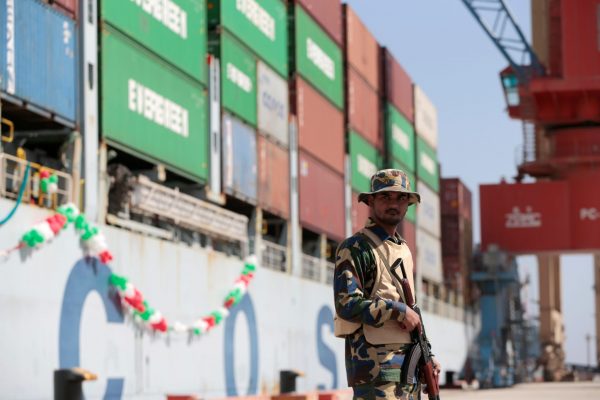A lack of transparency has resulted in ambiguity regarding the size of CPEC initiatives, with project investments reported at anywhere between US$36 billion to US$62 billion. In light of aspersions that the BRI is a debt trap for developing countries — and the United States warning that the IMF package should not be used to pay off Chinese loans — the Chinese Embassy in Pakistan issued a clarification in December 2018 that ‘22 early harvest projects under the CPEC have been completed or are under construction, with a total investment of $18.9 billion’.
But confusion persists as the Pakistan government’s CPEC website lists projects with an investment total of US$27.5 billion. Either way, investment under CPEC is large and CPEC has become a key driver of FDI into Pakistan.
As a result of the 2006 FTA, China–Pakistan trade has expanded rapidly with China’s share of Pakistan’s total trade increasing from less than 7 per cent in 2007 to about 17 per cent in 2018. But increases in Chinese imports were particularly dramatic after the start of CPEC and as a result, Pakistan’s trade deficit with China increased from US$2 billion in 2013 to almost US$10 billion in 2018, about one-third of the total trade deficit.
In the context of the balance of payments crisis in 2017–2018, the growing bilateral trade imbalance and the prospective burden of loan repayments and profit repatriations became emerging issues in China–Pakistan economic relations. China has successfully defused these by providing substantial short-term loans and deposits to help finance the balance of payments deficit. China has also given significant concessions in the second phase of the FTA, effective 1 July 2019, to potentially reverse the growing trade imbalance.
On 3 July 2019, the IMF approved a US$6 billion, 39-month loan for Pakistan. The key components of the IMF program are fiscal consolidation, a market-determined exchange rate and elimination of quasi-fiscal losses in the energy sector. All three could potentially have adverse implications for China–Pakistan economic relations.
Fiscal consolidation could either slow the completion of ongoing CPEC projects or force the abandonment of projects in their initial stages. Currency depreciation could increase the budgetary impact of interest and dividend payments for CPEC investments. Finally, the planned quarterly increases in electricity tariffs in fiscal year 2019 could reduce demand and thus the utilisation of the massive increase in generation capacity from CPEC projects in the power sector.
China has fully supported the IMF program, committing US$6.3 billion in the first year and maintaining its existing exposure throughout the program period. But as the IMF program is implemented over the next three years, these issues will continue to pose a challenge for the further development of China–Pakistan economic relations.
On the political front, it seems that both Washington and Beijing are providing due space to Pakistan to perform a balancing act, as long as their objectives are met. For Washington, it means Pakistan facilitating a peace deal in Afghanistan and taking adequate counter-terrorism measures. For Beijing it is primarily about strengthening ties formed under CPEC. Given the flagship status of CPEC in the BRI, China recognises the importance of making CPEC a success story, which requires a change in focus toward finding a permanent solution to the two potentially contentious issues.
While no further FDI in energy projects is expected, there are expectations that FDI in other sectors such as industry and services will grow. While there may be less focus on infrastructure, there could be other avenues for the bilateral economic relationship, such as industrial cooperation and trade enhancement, particularly through the development of Special Economic Zones (SEZs). The potential for private Chinese investment in industry to grow has become more likely because of second phase of the FTA and the large real devaluation of the Pakistani rupee.
The next few years are going to be difficult ones for Pakistan’s economy. Growth has slowed significantly and is unlikely to improve unless exports expand and Chinese investment in industry becomes a new driver of growth. For Pakistan, this means realigning its approach. This should include completing ongoing projects to ensure no lingering issues or reputational challenges and preparing for the next phase of CPEC — a CPEC focused on industrial cooperation and trade, making use of new FTA provisions, capitalising on devaluation and fixing SEZs.
China–Pakistan economic relations have developed significantly in the last decade. While it is possible that economic crisis and the IMF program could become major setbacks, the expectation is that these may result in the deepening of economic relations, with Pakistan’s economy becoming more integrated with China’s in the coming years. This would be the case if Chinese investments in industry and exports are substantial and can provide a stimulus for Pakistan’s much-needed growth recovery in the post-stabilisation IMF program period.
Naved Hamid is Professor of Economics at the Lahore School of Economics.
Hasaan Khawar is a Fellow at the Consortium for Development Policy Research, Lahore.

